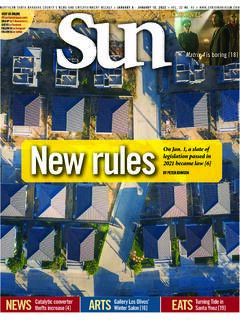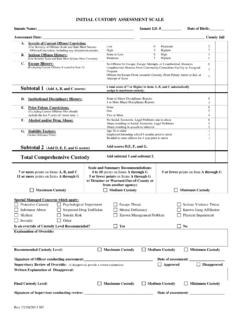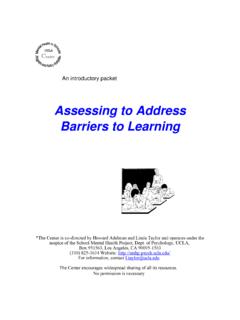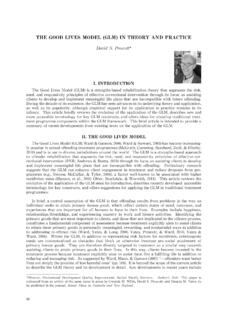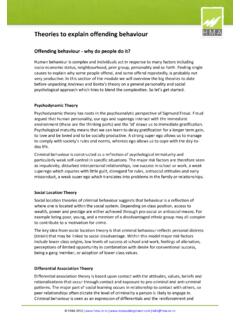Transcription of ADDRESSING COMMUNITY GANG PROBLEMS
1 Department of JusticeOffice of Justice ProgramsBureau of Justice AssistanceMonographADDRESSINGCOMMUNITYGA NG PROBLEMS :A Practical GuideThis document was prepared by the Police Executive Research Forum, supported by coop-erative agreement number 91 DD CX K058, awarded by the Bureau of Justice Assistance,Office of Justice Programs, Department of Justice. The opinions, findings, and conclu-sions or recommendations expressed in this document are those of the authors and do notnecessarily represent the official position or policies of the Department of Department of JusticeOffice of Justice Programs810 Seventh Street , DC 20531 Janet RenoAttorney GeneralRaymond C. FisherAssociate Attorney GeneralLaurie RobinsonAssistant Attorney GeneralNo l BrennanDeputy Assistant Attorney GeneralNancy E. GistDirector, Bureau of Justice AssistanceOffice of Justice ProgramsWorld Wide Web Home of Justice AssistanceWorld Wide Web Home grant and funding information Department of Justice Response Center1 800 421 6770 The Bureau of Justice Assistance is a component of the Office of Justice Programs, which alsoincludes the Bureau of Justice Statistics, the National Institute of Justice, the Office of JuvenileJustice and Delinquency Prevention, and the Office for Victims of of Justice AssistanceAddressing CommunityGang PROBLEMS :A Practical GuideMonographMay 1998 Reprinted August 1999 NCJ 164273iiiAddressing COMMUNITY gang PROBLEMS .
2 A Practical GuideForewordUrban street- gang involvement in drug trafficking and violent crime is be-coming increasingly widespread not just in large cities, but in suburbanareas and small towns as Bureau of Justice Assistance (BJA) recognizes that programs aimed atcombating gang -related activity must incorporate both crime preventionand crime control initiatives to be effective over long periods of time. Ac-cordingly, in October 1991, BJA initiated the development of a prototypemodel of the Comprehensive gang is pleased to present this monograph, ADDRESSING COMMUNITY GangProblems: A Practical Guide, as a product of that initiative. It is a useful toolthat provides guidelines for agencies and COMMUNITY groups to developindividualized responses to local gang PROBLEMS . This practical manualprovides a foundation for understanding the diverse nature of gangs, theproblems they pose and the harm they cause, and the two analytical mod-els for ADDRESSING gang -related companion monographs complement this one.
3 ADDRESSING CommunityGang PROBLEMS : A Model for problem Solving provides a prototype to assistcommunities in identifying, analyzing, and responding to gang -relatedproblems as well as assessing the effectiveness of their responses. UrbanStreet gang Enforcement focuses exclusively on enforcement and prosecu-tion strategies to protect against urban street gangs and presents strategiesto enhance the prosecution of gang -related E. GistDirectorvAddressing COMMUNITY gang PROBLEMS : A Practical GuideAcknowledgmentsThe Bureau of Justice Assistance (BJA) wishes to thank the Police Execu-tive Research Forum (PERF) and, in particular, John Stedman and DeborahLamm Weisel, for their help and guidance in compiling this also thanks the following individuals for their contributions:Deborah Lamm Weisel, Chapter P. McNamara, Chapters 2 and Nugent, Chapters 4 and Spelman, Chapter B.
4 Ayres, Chapter E. Capowich, Chapter COMMUNITY gang PROBLEMS : A Practical GuideContentsExecutive Summary .. xiiiI. Understanding Gangs and gang ProblemsChapter 1 Introduction .. 3 Analytical Models .. 4 Organization of the Monograph .. 6 Chapter 2 Defining the COMMUNITY s gang (s) .. 9 Which Definition To Use? .. 9 gang Diversity .. 11 COMMUNITY Concerns: What To Do? .. 14 Chapter 3 gang Involvement in Drugs and Violence .. 17 The Media s Social Distortion of Gangs .. 18 Historical Overview of Gangs .. 19 Types of Gangs .. 21 Gangs and Drugs .. 21 Drug Use .. 21 Drug Selling .. 22 Drugs and Violence .. 22 Gangs and Violence .. 23 The Relationships Among Gangs, Drugs, and Violence .. 26 COMMUNITY Responses to the problem .. 27 Chapter 4 gang Graffiti .. 29 What Are Graffiti? .. 29 Are Graffiti a problem ? .. 30 Graffiti as Street Art.
5 31 gang Graffiti .. 34 Reading Graffiti .. 37 Alphabets .. 37 Signs and Symbols .. 41 Ethnic Graffiti .. 43 Attacking a Graffiti problem .. 49 Controllers .. 49 Guardians .. 50viiiBureau of Justice AssistanceContents (continued)Manager .. 50 Offenders .. 51 Tools .. 53 problem Places .. 55 Responses .. 59 Establishing a Graffiti Policy .. 59 Reducing Availability of Graffiti Tools .. 59 Graffiti Removal Campaigns .. 60 Target Hardening .. 60 Discouraging Graffiti .. 61 Providing Alternatives to Taggers .. 61 Encouraging Public Responsibility .. 62 Assessment .. 64II. Learning About Local GangsChapter 5 Needs Assessments for gang PROBLEMS .. 67 What Is a Needs Assessment? .. 67 Aren't Communities Already Doing This? .. 69 What Is the Needs Assessment Looking For? .. 70 Step 1: Laying the Groundwork .. 72 First Steps .. 73 Scope and Focus.
6 75 Getting the Advisory Board To Buy In .. 77 Dealing With Conflict .. 77 Step 2: Identifying Current Activities .. 79 Defining What Information To Collect .. 80 Identifying Service Providers .. 83 Collecting Information .. 83 Displaying Results .. 84 Reaping the Benefits of Surveying .. 87 Step 3: Identifying and Setting Priorities Among 87 Surveying Clients and Their Advocates .. 87 Tracking and Comparing Social Indicators .. 96 Step 4: Developing a Consensus .. 103 Presenting Results to the Advisory Board .. 104 Going Public .. 105 Developing Solutions .. 106 Conclusion .. 107ixAddressing COMMUNITY gang PROBLEMS : A Practical GuideChapter 6 ADDRESSING gang PROBLEMS ThroughStrategic Planning .. 109 Using the Definition of gang To FrameCommunity Responses .. 109 Factors in gang Formation and Membership .. 110 Centrality of a ComprehensiveProblem-Solving Approach.
7 111 Building and Sustaining Coalitions .. 112 Functions of Coalitions .. 113 Initiating the Coalition-Building Process .. 114 Making Coalitions Work .. 115 Avoiding Pitfalls .. 116 Strategic Planning .. 117 Element 1: Mission Formulation .. 121 Element 2: Organizational Assessment .. 123 Element 3: Strategic Objectives Development .. 125 Element 4: Action Plan Development .. 129 Element 5: Implementation .. 134 Strategic Plan Evaluation .. 138 Internal and External Communication Strategies .. 139 Importance of Diverse Strategiesfor COMMUNITY Identity .. 139 Team Building .. 140 Assistance From an Outside Facilitator .. 140 Taking Time To Build the Team .. 143 Initial Team-Building Goals .. 144 Stages of Team Growth .. 145 Generating Ideas and Selecting Options .. 147 Conclusion .. 149 III. Responding to Local gang ProblemsChapter 7 Civil Remedies for gang -Related Harm.
8 153 Analytical Models .. 153 gang - problem Triangle .. 154 problem -Solving Model .. 154 problem Places .. 155 Residential Sites .. 157 Commercial Sites .. 158 Recreational Areas .. 158 Contents (continued)xBureau of Justice AssistancePublic Places .. 158 Transitional Places .. 159 Responsible People .. 159 Civil Remedies .. 161 Civil or Criminal or Both? .. 162 Injunction or Damages .. 162 Nuisance Abatement and Zoning Laws .. 163 Trespass .. 165 Waste .. 168 Civil Code Enforcement and Business Licensing .. 168 Residential Rental Properties .. 171 Vacant Buildings and Vacant Lots .. 172 Overcoming Barriers to Civil Remedies .. 172 Retaliation Against Individuals .. 172 Getting Public Officials To Cooperate .. 172 Delay on Civil Dockets .. 173 Case Examples of Civil Remedies .. 1745081 La Paz Drive, San Diego, California.
9 174609 East Benton, Joliet, Illinois .. 1761615 1617 Russell Street, Berkeley, California .. 180 gang - problem Triangle Applied .. 182 Conclusion .. 183 Chapter 8 Evaluating Anti- gang Efforts .. 185 Process Evaluations .. 187 Specifying the Program Elements .. 189 The Purposes of the Evaluation .. 189 Focusing the Evaluation .. 190 Collecting Data .. 191 Impact Evaluations .. 192 Causal Conclusions .. 193 Unit of Analysis .. 194 Levels and Types of Effects .. 194 Appropriate Measures and Data .. 196 Data Collection .. 197 Design and Analysis .. 198 Overview of Process and Impact Evaluations .. 199 Appendix AReferences .. 201 Appendix BSources for Further Information .. 207 Contents (continued)xiAddressing COMMUNITY gang PROBLEMS : A Practical GuideExhibitsExhibitTitlePage1 Narrowing the Gap Between Taggers andGangs, Lakewood, Colorado.
10 35 2 How Taggers Dress, Lakewood, Colorado .. 36 3 Differences Between Tagger and gang Graffiti .. 37 4 Hispanic gang Lettering Styles .. 38 5 Barrio Lettering in Old English .. 39 6 Corona in Old English .. 39 7 SSG in Sharp-Point Letters .. 39 8 Peace and Cats in Bubble Letters .. 40 9 El Blackbird P 12 St in Loop Letters .. 4110 Swastika in Oriental/American Indian Style Letters .. 4111 Nazi Swastika .. 4112 Six-Pointed Star .. 4213 Five-Pointed Star .. 4214 Hexagram, Pentagram, and Upside-Down Pentagram .. 4215 Celtic Cross .. 4316 Form e Cross .. 4317 Ankh Cross .. 4318 Guides to Hispanic gang Graffiti .. 4419 Black gang Graffiti .. 4520 White-Power Graffiti .. 4721 Removing Graffiti: Markers and Surfaces .. 5422 Wheel of Misfortune .. 7123 Austin Project Board of Directors .. 7424 What a Current Activities Survey Can Reveal.










